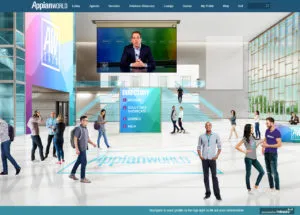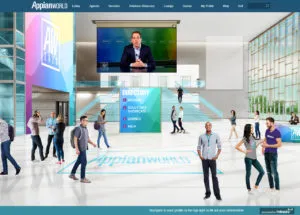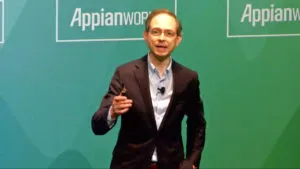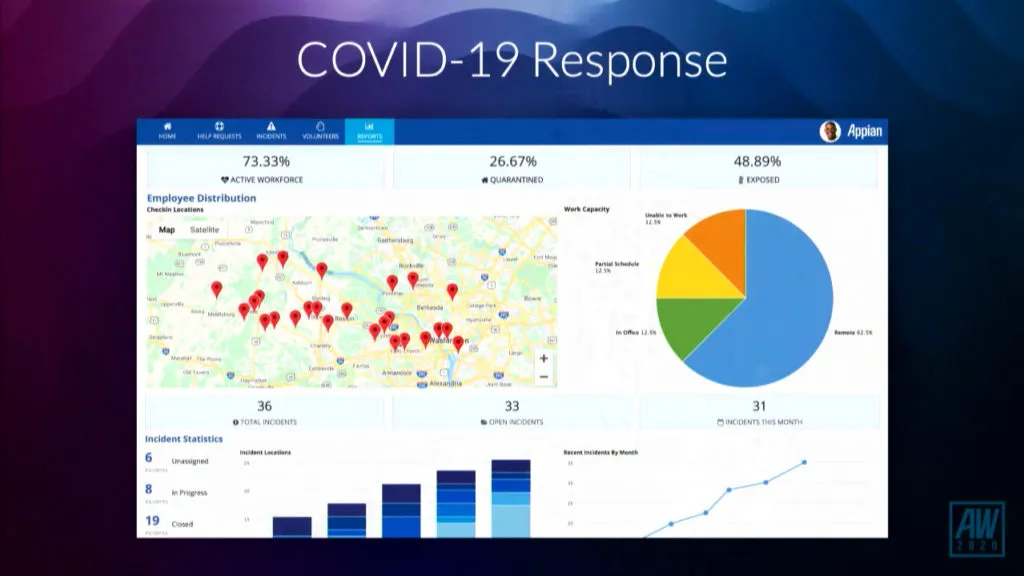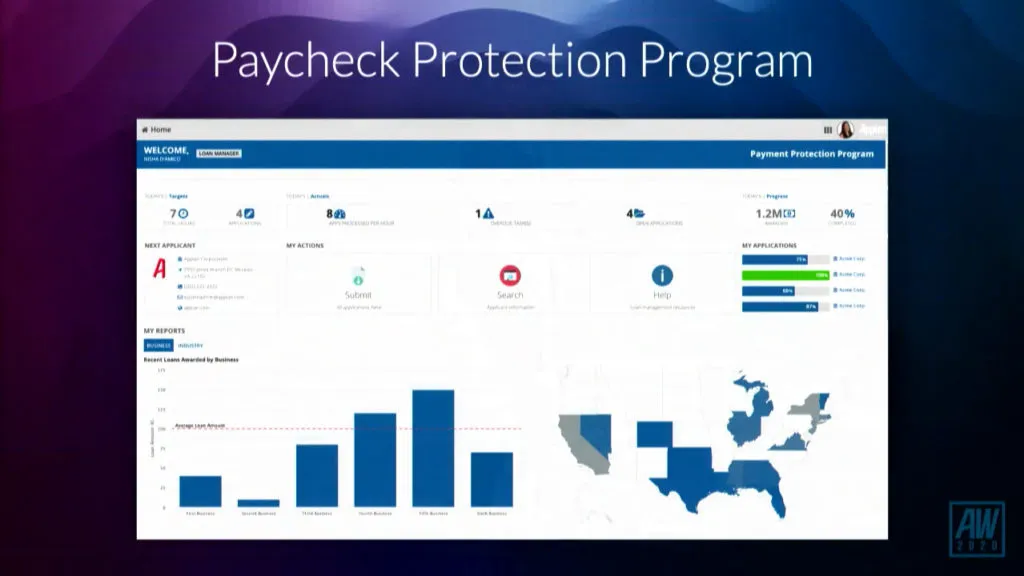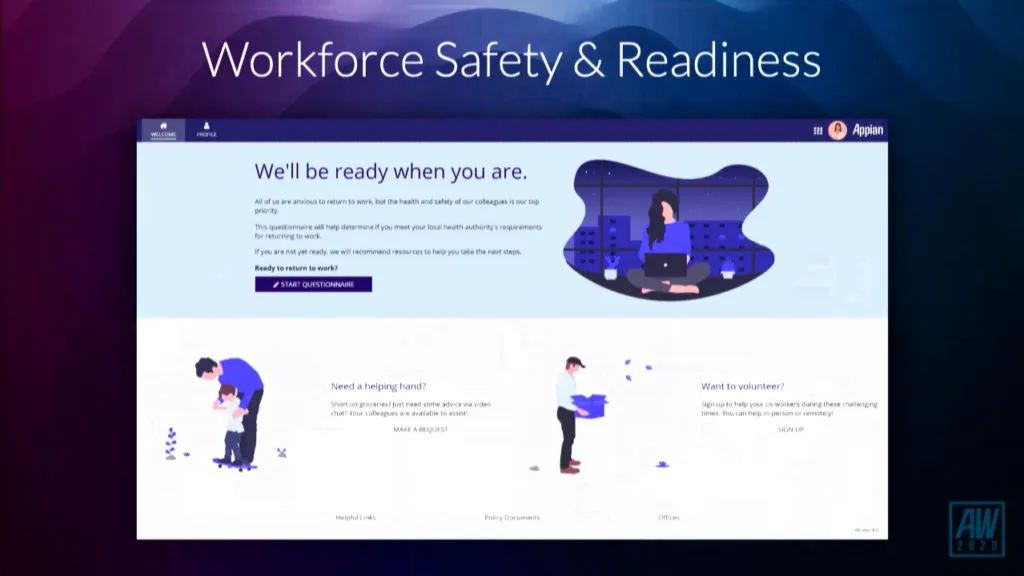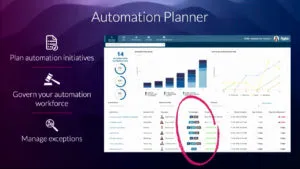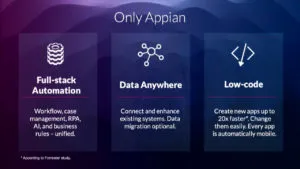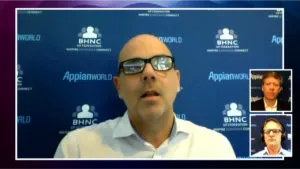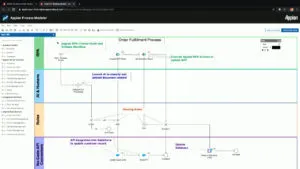Appian World 2020 – Day 1: good keynotes and too many breakout sessions
Blog: Column 2 - Sandy Kemsley
Another week, another virtual event! Appian World is happening two days this week, and will be available on-demand after. This has a huge number of sessions on several parallel tracks, which are pre-recorded, but with live keynotes in advance. From their site:
Keynote sessions are live from 10:00 AM – 12:00 PM EDT on May 12th and 13th. All breakout sessions will become available on-demand at 12:00 PM EDT on their scheduled day, immediately following the live keynote. Speakers will be available from 12:00 PM – 3:00 PM EDT for live Q&A on their scheduled session day.
They’re using the INXPO platform, and apparently using every possible feature. Here’s a bit of navigation help:
- There’s a Lobby tab with a video greeting from Appian CMO Kevin Spurway. It has links to the agenda, solutions showcase and lounge, which is a bit superfluous since those are all top-level tabs visible at all times.
- The Agenda tab lists the sessions for today, including the keynote (for some reason it showed as Live from 8:30am although the keynotes didn’t start until 10am), then all of the breakout sessions for the day, which you can dip into in any order since they are all pre-recorded and are made available at the same time.
- The Sessions tab is where you can drill down and watch any of the sessions when they are live, but you can also do this directly from the Agenda tab. Sessions has them organized into tracks, such as Full Stack Automation Theater and Low-Code Development Theater.
- The Solutions Showcase tab is virtual exhibit hall, with booths for partners and a pavilion of Appian product booths. These can have a combination of pre-recorded video, documents to download, and links to chat with them. It’s a bit overwhelming, although I supposed people will go through some of the virtual booths after the sessions, since the sessions run only 10-3 each day. I suppose that many of these partners signed on for Appian World before it moved to a virtual event, so Appian needed to provide a way for them to show their offerings.
- The Lounge tab is a single-threaded chat for all attendees. Not a great forum for discussion: as I’ve mentioned on all of the other virtual conference coverage in the past couple of weeks, a separate discussion platform like Slack that allows for multi-threaded discussions where audience members can both lead and participate in discussions with each other is much, much better for audience engagement.
- The Games tab has results for some games that they’re running — this is common at conferences, such as how many people send out tweets with the conference hashtag, or getting your ID scanned by a certain number of booths, but not something that adds value for my conference experience.
The keynote speakers appeared on a stage in Appian’s own auditorium, empty (except supposedly for each other and production staff). CEO Matt Calkins was up first, and talked about how the world has changed in 2020, and how their low-code application development can help with the changes that are being forced on organizations by the pandemic. He talked about the applications that they have built in the past couple of months: a COVID-19 workforce tracking app, a loan coordination app that uses AI and RPA for automation, and a workforce safety & readiness app that manages how businesses reopen to their workforce coming back to work. They have made these free or low-cost for their customers for the near term.
His theme for the keynote is automation: using human and digital workers, including RPA and AI, to get the best results. He mentioned BPM as part of their toolbox, and focused on the idea that the goal is to automate, and the specific tool doesn’t matter. They bought an RPA company and have rebranded it as AppianRPA: it’s cloud-native and Java-based, which is different from many other RPA products, but is more appealing to the CIO-level buyer for organization-wide implementations. They are pushing an open agenda, where they can interact with other RPA products and cloud platforms: certainly as a BPM vendor, interaction with other automation tools is part of the fabric.
They have a few new things that I haven’t seen in briefings (to be fair, I think I’ve dropped off their analyst relations radar). Their “Automation Planner” can make recommendations for what type of automation to use for any particular task. Calkins also spoke about their intelligent document processing (IDP), which addresses what they believe is one of the biggest automation challenges that companies have today.
The Appian platform offers full-stack automation — workflow, case management, RPA, AI, business rules — with a “data anywhere” philosophy of integrating with systems to allow processing data in place, and their low-code development for which they have become known. If you’re a fan of the all-in-one proprietary platform, Appian is definitely one of main contenders. They have a number of vertical solutions now, and are starting to offer standardized all-inclusive subscription pricing for different sizes of installations that removes a lot of uncertainty about total cost of ownership. He also highlighted some of the vertical applications created by partners PWC, Accenture and KPMG.
I always like hearing Calkins talk (or chatting with him in person), because he’s smart and well-spoken, and ties together a lot of complex ideas well. He covered a lot of information about Appian products, direction, customers and partners in a 30-minute keynote, and it’s definitely worth watching the replay.
Next up was a “stories from the front line of COVID-19” panel featuring Darin Cline, EVP of Operations of Bank of the West (part of BNP Paribas), and Darren Blake, COO of Bexley Health Neighbourhood Care in the UK National Health Service, moderated by Appian co-founder Mark Wilson. This was done remotely rather than in their studio, with each of the three having an Appian World backdrop: a great branding idea that was similar to what Celonis did with their remote speakers at Celosphere, although each person’s backdrop also had their own company’s logo — nice touch.
Blake talked about how they saw the wave of COVID-19 coming based on data that they were seeing from around the world, and put plans in place to leverage their existing Appian-based staff tracker to implement emergency measures around staff management and redeployment. They support home-based services as well as their patients’ visits to medical facilities, and had to manage staff and patient visits for non-COVID ailments as well as COVID responses and even dedicated COVID testing clinics without risking cross-contamination. Cline talked about how they needed to change their operations to allow people to continue accessing banking services even with lockdowns that happened in their home state of California. He said this disruption has pushed them to become a much more agile organization, both in business and IT departments: this is one of those things that likely is never going back to how it was pre-COVID. He credited their use of Appian for low-code development as part of this, and said that they are now taking advantage of it as never before. Blake echoed that they also have become much more agile, creating and deploying new capabilities in their systems in a matter of a few days: the vision of all low-code, but rarely the reality.
Interesting to hear these customers stories, where they stepped up and started doing agile development in the low-code platform that they were already using, listening to the voice of the customer in cooperation with their business people, executives and implementation partners such as Appian. So many things that companies said were just not possible actually are: fast low-code implementation, work from home, and other changes that are here to stay. These are organizations that are going to hit the ground running as the pandemic recedes — as Blake points out, this is going to be with us for at least two years until a vaccine is created, and will have multiple waves — since they have experienced a digital revolution that has fundamentally changed how they work.
Great customer panel: often these are a bit dry and unfocused, but this one was fascinating since they’ve had a bit of time to track how the pandemic has impacted their business and how they’ve been able to respond to it. In both cases, this is the new normal: Cline explicitly said that they are never going back to having so many people in their offices again, since both their distributed workforce and their customers have embraced online interactions.
Next up was deputy CTO Malcolm Ross (who I fondly remember as providing my first Appian demo in 2006) with a product update. He showed a demo that included integration of RPA, AI, IDP, Salesforce and SAP within the low-code BPM framework that ties it all together. It’s been a while since I’ve had an Appian briefing, and some nice new functionality for how integrations are created and configured with a minimum of coding. They have built-in integrations (i.e., “no code”) to many different other systems. Their AI is powered by Google’s AI services, and includes all of the capabilities that you would find there, bundled into Appian’s environment. This “Appian AI” is at the core of their IDP offering, which does classification and data extraction on unstructured documents, to map into structured data: they have a packaged use case that they provide with their product that includes manual correction when AI classification/extraction doesn’t have a sufficient level of confidence. Because there’s AI/ML behind IDP, it will become smarter as human operators correct the errors.
He went through a demo of their RPA, including how the bots can interact with other Appian automation components such as IDP. There is, as expected, another orchestration (process) model within RPA that shows the screen/task flow: it would be good if they could look at converging this modeling format with their BPM modeling, even though it would be a simple subset. Regardless, a lot of interesting capabilities here for management of robotic resources. If you’re an existing Appian customer, you’re probably already looking at their RPA. Even if you’re already using another RPA product, Appian’s Robotic Workforce Manager allows you to manage Blue Prism, Automation Anywhere and UiPath bots as well as AppianRPA bots.
The last part of the morning keynotes was a panel featuring Austan Goolsbee, Former Chairman of President Obama’s White House Council of Economic Advisers, and Arthur Laffer, Economist and Member of President Reagan’s Economic Policy Advisory Board, moderated by Matt Calkins. This was billed as a “left versus right” economists’ discussion on how to reopen the (US) economy, and quickly lost my interest: it’s not that I’m not interested in the topic, but prefer to find a much wider set of opinions than these two Americans who turned it into a political debate, flinging around phrases such as “Libertarian ideal”. Not really a good fit as part of a keynote at a tech vendor conference. I think this really highlights some of the differences between in-person and virtual conferences: the virtual tech conferences should stick to their products and customers, and drop the “thought leaders” from unrelated areas. The celebrity speakers have a slight appeal to some attendees in person, but not so much in the virtual forum even if they are live conversations. IBM Think had a couple of high profile speakers that I skipped, since I can just go and watch their TED Talk or YouTube channel, and they didn’t really fit into the flow of the conference.
The remaining three hours of day 1 were (pre-recorded) breakout sessions available simultaneously on demand, with live Q&A with the speakers for the entire period. This allows them to have a large number of sessions — an overwhelming 30+ of them — but I expect that engagement for each specific session will be relatively low. It’s not clear if the Q&A with the speaker is private or if you would share the same Q&A with other people who happened to be looking at that session at the same time; even if they were, the session starts when you pop in, so everyone would be at a different point in the presentation and probably asking different questions. It looks like a similar lineup of breakout sessions will be available tomorrow for the afternoon portion, following another live keynote.
I poked into a couple of the breakout sessions, but they’re just a video that starts playing from the beginning when you enter, no way to engage with other audience members, and no motivation to watch at a particular time. I sent a question for one speaker off into the void, but never saw a response. Some of them are really short (I saw one that was 8 minutes) and others are longer (Neil Ward-Dutton‘s session was 36 minutes) but there’s no way to know how long each one is without starting it. This is a good way to push out a lot of content simultaneously, but there’s extremely low audience engagement. I was also invited to a “Canada Drop-In Centre” via Google Meet; I’m not that interested in any sort of Canadian-specific experience, a broader based engagement (like Slack) would have been a better choice, possibly with separate channels for regions but also session discussions and Q&A. They also don’t seem to be providing slide decks for any of the presentations, which I like to have to remind me of what was said (or to skip back if I missed something).
This was originally planned as an in-person conference, and Appian had to pivot on relatively short notice. They did a great job with the live keynotes, including a few of the Appian speakers appearing (appropriately distanced) in their own auditorium. The breakout sessions didn’t really grab me: too many, all pre-recorded, and you’re basically an audience of one when you’re in any of them, with little or no interactivity. Better as a set of on-demand training/content videos rather than true breakout sessions, and I’m sure there’s a lot of good content here for Appian customers or prospects to dig deeper into product capabilities but these could be packaged as a permanent library of content rather than a “conference”. The key for virtual conferences seems to be keeping it a bit simpler, with more timely and live sessions from one or two tracks only.
I’ll be back for tomorrow’s keynotes, and will have a look through the breakout sessions to see if there’s anything that I want to watch right now as opposed to just looking it up later.
